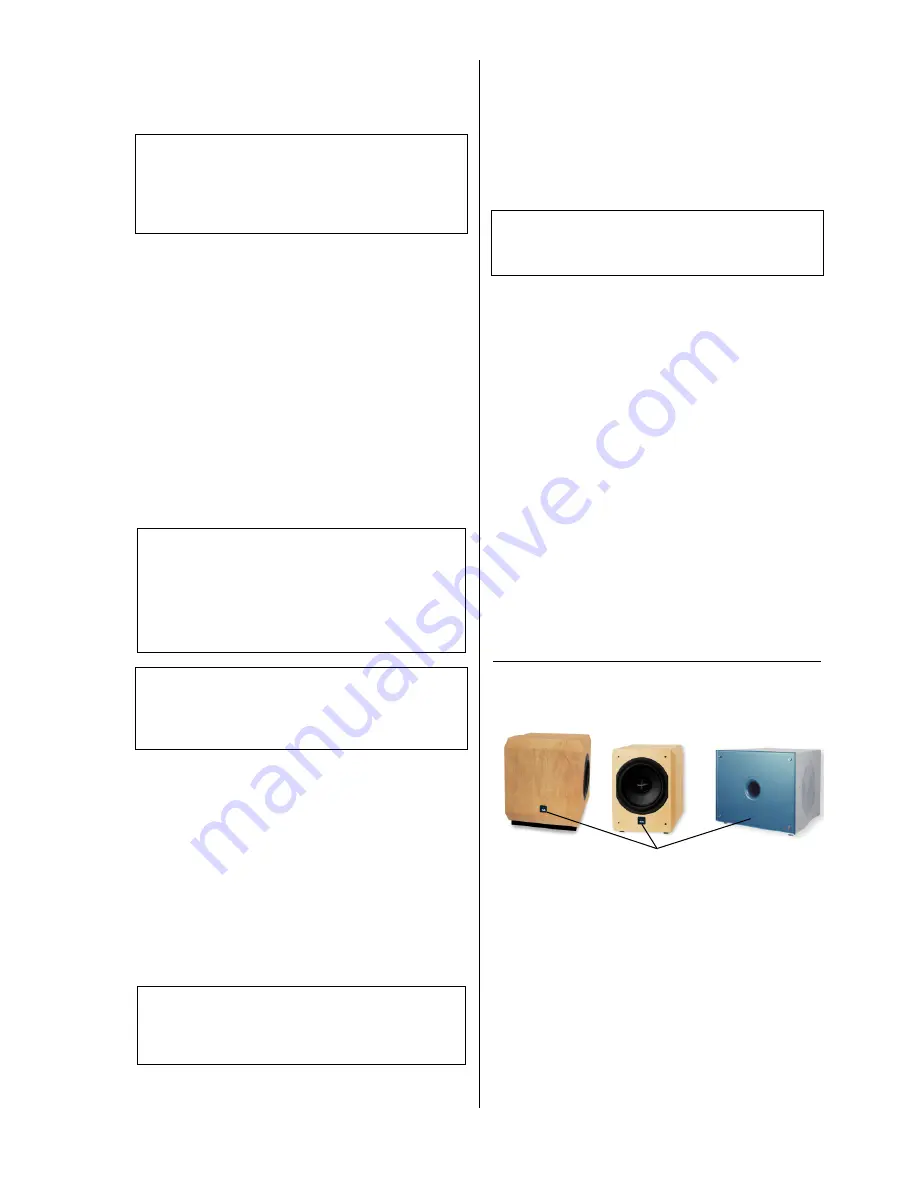
17
HI LEVEL IN
*)
If the signal to the sub-woofer is to be supplied by a
power amplifier, connect the amplifier output to these in-
put sockets.
Notes:
If you are using the
HI LEVEL
sockets it is absolutely
essential to avoid short-circuits between the terminals!
Maintain correct polarity:
be sure to connect the
red
‘
+
’
terminals to the power amplifier’s
red
‘
+
’ output
terminals.
CINCH IN
*)
If the signal to the sub-woofer is to be supplied by a pre-
amplifier, connect the pre-amplifier outputs to these input
sockets.
These sockets are also used to connect the speaker to
the sub-woofer output of a surround decoder. If only one
output is available, it is sufficient to connect this to one of
the sub-woofer’s inputs (e. g. the left one), as the two
inputs are identical.
DIN IN (SC
LINK
)
*)
Input socket for
units with an
SC
LINK
output. In
addition to the music signal, this socket passes a
switching signal for the automatic power-on circuit, and
control information for the internal crossover filters.
Note:
Even machines not fitted with a
SC
LINK
output can
switch the sub-woofer on and off using this socket,
provided that they generate a switching voltage (+5V . . .
+15V). In this case please contact the
Service
Department for a suitable adaptor lead (see also the
section
‘Specification’
for the pin assignment of the 8-
pin
SC
LINK
DIN socket).
*) Note:
The input sockets
HI LEVEL IN
,
CINCH IN
and
DIN IN
(SC
LINK
)
must not be used simultaneously! Please
decide which
type of connection
you wish to use (see
section
‘Wiring variants’
).
LEVEL
This adjustor is used to regulate the amplification of the
active unit. Adjust the level to set the bass output to
match that of your satellite loudspeakers.
PHASE (
0
°
- 180
°)
The
PHASE switch
can be used to invert the phase of
the output signal, i. e. turn it through
180°
compared to
the input signal.
The
PHASE adjustor
provides fine-tuning of phase over
the range
+90°
. . .
-90°
.
Notes:
It may be advantageous to change the phase, depending
on the position of the sub-woofer. We suggest that you
adjust the settings until you obtain the most pleasing
subjective impression in the bass / mid-range area.
CUT-OFF FREQUENCY
This adjustor is used to adjust the separation frequency
between sub-woofer and satellite loudspeakers. The
larger the satellite speakers, the lower the separation
frequency that should be set.
Set the separation frequency to the lowest point
commensurate with the frequency response of the
satellite speakers, otherwise the physical location of the
sub-woofer may become apparent when listening.
Note:
This switch is only effective if the filter is switched on,
i. e. the
FILTER
switch
must be at the
‘ON CTRL’
position.
FILTER ON CTRL / OFF
The purpose of this switch is to switch the internal
crossover on and off.
If the sub-woofer is connected to the sub-woofer output
of a surround decoder which features an integral cross-
over unit, the switch should be set to ‘
OFF
’.
If the sub-woofer is operated with a signal source which
does not feature an integral filter (normal stereo system),
the switch must be set to
‘ON CTRL’
.
If you wish to be able to switch the internal filters via the
SC
LINK
facility, the
Filter
switch must be set to the
‘
ON CTRL
’ position.
POSITION
This switch adjusts the bottom limit frequency and the
level of the sub-woofer to suit the speaker’s location in
the listening room.
Select the
‘WALL/FREE’
if the speaker is located close
to a wall, or is standing freely in the room; select the
‘CORNER’
setting for a corner location.
LED on the sub-woofer front panel
Criterion TCI W2
Criterion TAL XW Talis TLW 4 A
LED
LED GLOWS RED:
The sub-woofer is in stand-by mode, and is switched on
automatically when a music or control signal is received.
LED GLOWS GREEN:
The active unit is operating.
LED FLASHES RED:
The output stage has switched itself off due to over-loading
or overheating (PROTECTION). Please lower the volume.
After a while the sub-woofer will switch itself back on
automatically, at which point the LED stops flashing.
LED FLASHES GREEN:
Power-on delay running. The sub-woofer signal is only
reproduced when the delay period has elapsed!
















































